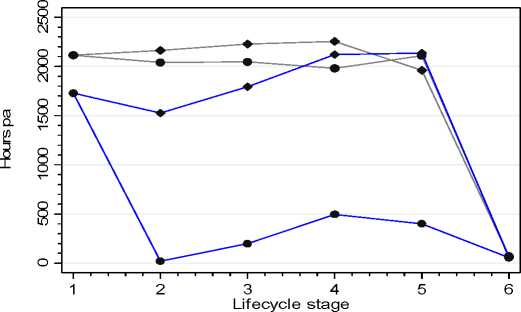full time or not at all. If we select female records aged 25 to 59 years from the full
sample of couples in the IHS, we find that 35.4 per cent are employed full time and
30.1 per cent have zero hours. Thus, a total of 65.5 per cent are at the extremes of the
distribution. In contrast, the vast majority of males in the same age category, 83.6 per
cent, are employed full time. Since almost all married women in phase 1 are in full
time work, this heterogeneity in female hours is driven by variation in hours across
phases 2 to 5. In these phases households tend to divide into two groups: those in
which the female partner works few hours in the market or not at all, and those in
which she works full time or relatively long part-time hours.
We split the sample into these two groups within each of these phases. The first
group, labelled H1, represents households in which the female partner works below
median female hours, and the second, H2, those in which she works above median
hours. The separate labour supply profiles of the two groups, based on weighted data
means, are plotted in Figure 4. The figure shows graphically the very different work
choices of married mothers in phase 2, and the persistence of heterogeneity in those
choices until retirement in phase 6.
Figure 4: Labour supplies by household type

Males-Hl--Females-Hl
Males-H2 -- -- Females-H2
Partitioning the sample into lifecycle phases on the criteria outlined has the effect of
controlling for the presence and age of children but not for family size. If the H1
14
More intriguing information
1. Feature type effects in semantic memory: An event related potentials study2. The name is absent
3. Rural-Urban Economic Disparities among China’s Elderly
4. Examining the Regional Aspect of Foreign Direct Investment to Developing Countries
5. Estimating the Impact of Medication on Diabetics' Diet and Lifestyle Choices
6. A Rational Analysis of Alternating Search and Reflection Strategies in Problem Solving
7. Quality Enhancement for E-Learning Courses: The Role of Student Feedback
8. Optimal Rent Extraction in Pre-Industrial England and France – Default Risk and Monitoring Costs
9. Word searches: on the use of verbal and non-verbal resources during classroom talk
10. The name is absent